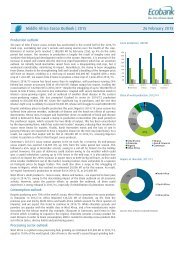www.ebook777.com
Make_Getting_Started_with_Processing_Second_Edition
Make_Getting_Started_with_Processing_Second_Edition
Create successful ePaper yourself
Turn your PDF publications into a flip-book with our unique Google optimized e-Paper software.
}<br />
JSONObject weather = loadJSONObject(fileName);<br />
JSONArray list = weather.getJSONArray("list");<br />
JSONObject item = list.getJSONObject(0);<br />
JSONObject main = item.getJSONObject("main");<br />
float temperature = main.getFloat("temp");<br />
return temperature;<br />
The name of the JSON file, cincinnati.json, is passed into the get<br />
Temp() function inside setup() and loaded there. Next, because<br />
of the format of the JSON file, a series of JSONArray and JSONOb<br />
ject files are needed to get deeper and deeper into the data<br />
structure to finally arrive at our desired number. This number is<br />
stored in the temperature variable and then returned by the<br />
function to be assigned to the temp variable in setup() where it is<br />
printed to the Console.<br />
Example 12-7: Chaining Methods<br />
The sequence of JSON variables created in succession in the<br />
last example can be approached differently by chaining the get<br />
methods together. This example works like Example 12-6 on<br />
page 178, but the methods are connected with the dot operator,<br />
rather than calculated one at a time and assigned to objects in<br />
between:<br />
void setup() {<br />
float temp = getTemp("cincinnati.json");<br />
println(temp);<br />
}<br />
float getTemp(String fileName) {<br />
JSONObject weather = loadJSONObject(fileName);<br />
return weather.getJSONArray("list").getJSONObject(0).<br />
getJSONObject("main").getFloat("temp");<br />
}<br />
Also note how the final temperature value is returned by the<br />
getTemp() function. In Example 12-6 on page 178, a float variable<br />
is created to store the decimal value, then that value is<br />
returned. Here, the data created by the get methods is returned<br />
directly, without intermediate variables.<br />
This example can be modified to access more of the data from<br />
the feed and to build a sketch that displays the data to the<br />
Data 179



